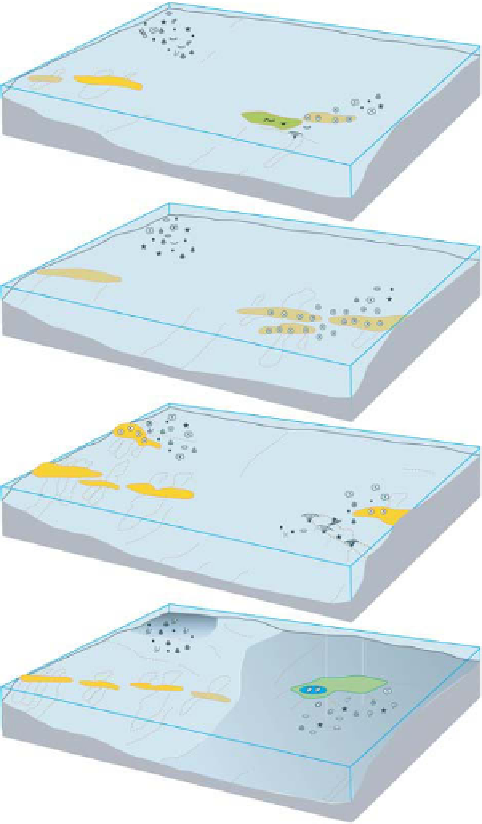Geology Reference
In-Depth Information
Climate
Hautes-
Roches
Pertuis
Savagnières
Gorges
de Court
General climate models for the Late Jurassic have
been developed by Oschmann (1990), Frakes
et al
.
(1992), Sellwood & Valdez (1997), or Abbink
et al
.
(2001). These models, however, do not consider
short-term climate variations. Orbital cyclicity
causes changes in the total amount of insolation
and in its seasonal distribution, which then result
in latitudinal shifting of atmospheric circulation
cells and concomitant changes in seasonality,
rainfall pattern, oceanic circulation and sea-sur-
face temperatures (Matthews & Perlmutter, 1994).
In the sections studied, siliciclastics are in many
cases concentrated around small-scale sequence
boundaries and associated with plant material
(Fig. 6). This implies that during sea-level fall cli-
mate in the hinterland was rather humid, increas-
ing the terrigenous runoff and allowing vegetation
growth. Coral reefs and ooid shoals are situated
preferentially in the trangressive parts of small-
scale and medium-scale sequences in the absence
of siliciclastics, suggesting a rather dry and warm
climate. However, there are many exceptions to
these trends, so that humid-dry changes can be
considered as only one controlling factor among
several others. There is no evidence for arid con-
ditions as no evaporites have been observed in
the sections studied. It is interesting to note that
in Upper Oxfordian sections in Spain, in a more
southern palaeolatitudinal position, the siliciclas-
tics are preferentially associated with maximum
fl ooding in small-scale sequences (Pittet & Strasser,
1998). This implies that rainfall there occurred
during rising sea-level and places the Spanish sec-
tions in a different palaeoclimatic zone than those
in the Swiss Jura.
The estimation of water temperature is diffi cult.
Based on
Vorbourg
Sequence boundary
seasonally wet ?
(d)
Maximum flooding
dry climate
(c)
Sequence
boundary
(b)
Sequence boundary
humid climate
(a)
Fig. 10.
Sketches of depositional environments along the
time lines indicated in Fig. 9. Platform morphology has
been reconstructed to be compatible with the evolution of
facies and sequences observed in the sections studied. For
discussion refer to text. No palinspastic correction has been
applied: the distances between the sections may therefore
be somewhat different from Late Jurassic times but their
relative positions have not changed.
18
O analyses on modifi ed whole rock,
Plunkett (1997) derived an average palaeotemper-
ature of 26-27°C for samples in the Vorbourg and
Gorges de Court sections. The isotopic variations
within individual depositional sequences, how-
ever, are too weak to be interpreted confi dently as
high-frequency temperature changes.
δ
south, whereas lagoons formed in the depressions
towards the north (Fig. 10). The relief created by
tectonics therefore contributed signifi cantly to
the general facies distribution. Furthermore, the
irregular distribution of siliciclastics (Fig. 6) can
be explained by depressions, which were created
by differential subsidence and served as con-
duits (Pittet, 1996; Hug, 2003). The preferential
growth of reefs and the initiation of ooid shoals on
tectonic highs further enhanced the relief.
Ecology
The most conspicuous carbonate-producing eco-
systems in the sections studied are coral patch
reefs. They occur in different stratigraphic positions
and the individual reef bodies never lived longer
than the duration of an elementary sequence,
i.e. 20 kyr (Figs 6 and 9). The Oxfordian reefs






















































































